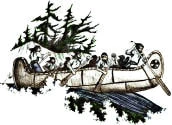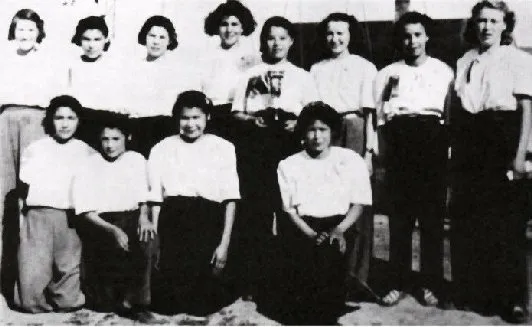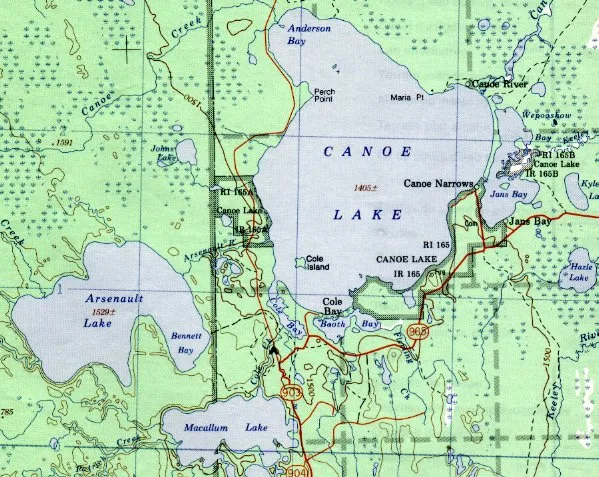
Les Metisse ... Mothers and Grandmothers


Claudia Lariviere
Claudia is fifty-nine years old, and a resident of Ile-a-la-Crosse. "I was born on Big Island, the earliest I can remember was when we lived in Fort Black with my mom and grandparents. Then my mother died and Father Rossignol took me in. I then grew up in the mission. It was busy. I went to school for awhile and then helped peel potatoes. Later the Sisters showed me how to sew. The mission was always poor. I remember when there was a special occasion, such as Easter, we would be satisfied with one egg placed under the table. We never saw butter. On special occasions, we were fed potatoes and lard in the morning". "Once, the mission burned. The curtains were too close to a wood stove and they caught fire. This was about five o'clock in the morning. We had to run out in our gowns. They found us a place to stay after that. That place was in the attic of Father's house. We lived and played up there. We never saw the outside life. I never saw the Bay and other places in town, because we weren't allowed to go anyplace. My grandma used to visit me at the convent. We were so innocent. I never knew those things existed until I got married. It was so different". 
Photo (Courtesy: Robert Longpre).
Sister Therese Arcand
Sister Arcand is a member of the Grey Nuns. She was born at Green Lake and went to school at Ile-a-la-Crosse. Today, she is doing Mission work in Ile-a-la-Crosse. Sister Arcand was the first Metis student of Ile-a-la-Crosse to join the Sisters of Charity. "In 1920, I was in Green Lake. I had about two brothers at the Ile-a-la-Crosse school. When I came, it was Christmas Eve, 1920, I remember that day very well. It was a hard journey from Green Lake because it was a very cold winter. We traveled by sleigh on the winter road along Beaver River. We finally did get there. My mother brought me to the school, the boarding house, and I was left with the Sister. My mother went off to stay where my aunties were in the village. There were not too many houses. They put me in Church first of all because I was always in the way". "The Sisters were preparing the "Creche". They asked me to put some of the decorations on the little statues, This was my first contact with the Church. I was happy, but at the same time, I was very, very lonesome. I should have come to school the year before, I guess, but, I couldn't decide to leave my mother. I had a little brother with me. I didn't mind it too much". "At holidays in June, there used to be two men who would come to Green Lake by canoe to here. They'd turn back and we would go home with them. We would go to Beauval and camp, then go up the Beaver River and camp again. It seems to me we camped three times on the way. Finally we were home. We stayed there the best part of two months. At the middle of August we had to come back to school again, and, I just cried!" 
(Courtesy: Robert Longpre). 
(Photo Courtesy: Ile-a-la-Crosse Mission). "I never found it easy to leave home. Never! I went home for the summers of '22 and 23' and then I didn't go back home again. I've stayed on with the Sisters ever since". I loved school very much, especially geography. Everything else could go, but I had to read this geography book with its big fat cover. It told all about the world, Calcutta, Bangkok and the rest of them. I tell you it was just as if it were the bible". "We'd always rise at about 5:30 or 6:00 in the morning. We'd have to carry our own water. We washed up and made our beds before we came down and said our morning prayers. Then after Mass, we went to breakfast which lasted not very long. Some girls were assigned to wash dishes, others to separate milk. Then we had other chores like cleaning oil lamps and filling them with oil". "Around a quarter to nine we got ready for class. Those who had no chores to do had been up in their rooms mending their clothes or the clothes of the other younger children. We didn't play in the morning. This was work time". "At nine o'clock, we walked to school and sat at our double desks where two of us sat. We didn't have scribblers in those days, we had slates. We had a little cloth to wipe them clean. First we did arithmetic, the French grammar, spelling and reading. After this we'd have Bible History. I don't remember having recess though. We were very disciplined. I enjoyed school". "Then we'd go for dinner. After dinner, we always hurried our eating-I don't think I even bothered to chew my food-it was play time. It was a great penance if some of us had to be assigned to do the dishes. Playing was done outside". "Then we went to school. Now we had English class. We did geography, history and English reading, spelling and grammar. Before we left school we always sang for fifteen minutes. We went outside to play for a half hour. At 4:30 it was sewing time for a half hour. Then it was time for prayer. Supper was after prayers. Then chores, then upstairs. It seems to me we started getting ready for bed at 7:30. At eight o'clock we were in bed". "Morning lessons in school were taught in French. In the afternoons we went with Sister Tucker, who replaced Sister Nadeau who had drowned. She taught us in English. Sister Tucker was a very, very slow person. That's why I had lots of time to study my geography". "I'd rise early in the morning to help with the bread. We'd always have porridge in the morning and I only had that to cook for the meal. The food was very simple, but was plentiful, that's why I grew up so big. We had lots of vegetables. We had a great big garden right beside the house. We helped to plant this garden first of all. Second we hoed it. We did detest it, but anyway we did it. Then we'd pray for rain so that we would have vegetables galore". "We spent a lot of time outside. We played and we worked. It was much more like a family. We always dressed up. We were never really cold, even on some of the coldest days". "Then the big day came when I had to leave. We left on the 29th of March, 1929. We traveled from here to Beauval in a sleigh. But, before going, I raised my head and looked at the mission from top to bottom. I thought of the things that had happened to me. Then I came across the face of a girl who had just come to Ile-a-la-Crosse. She was crying. I then said to myself. "I will go in training and come back to help my people." That was my last thought while in Ile-a-la-Crosse". 
(PA 44565 Public Archives of Canada).
Webmasters Note
I have added a brief article by another outstanding Metis Lady to this webpage. It is not part of the original book, but, I think it is an appropriate addition to which no one will object. It was written in October 1983, and is translated from Plains Cree.
Introduction by Vye Bouvier
Two miles from the Primrose Lake Air Weapons Range and ten miles from Cole Bay, at the end of a drive on a narrow, winding gravel road, lives an eighty-three year old wonder of a woman. She serves you strong black tea when you enter and offers you whatever she has if you haven't eaten. She told me where the Metis had lived around Canoe Lake, who was related to whom, about how she used to sail her canoe and she taught me Cree, to improve my meager vocabulary. I left feeling wealthy in having known the wisdom of this strong, intelligent woman. Victoria Iron Bouvier moves out to her home at Kisipigamuk (the end of the lake) in the spring and returns to her other house in the village of Cole Bay in the winter. Born on February 6th, 1900, Victoria still walks out into the bush to trap. She lives with Donald, a thirty year old adopted son, who loves the bush as much as she does. Victoria's paternal grandmother, was known as one of the best herbalists in the area. Victoria and her sisters are carrying on that tradition. Our conversation began, as it usually does when I visit elderly people, with a family tree that ties her family to my family. Northwestern Saskatchewan Native people are inevitably related. Victoria's mother, Margaret Marie Daigneault, was a Cree French Metis from Ile-a-la-Crosse. Margaret Marie's sister, Lucia, was my paternal grandmother's mother. Victoria and my grandmother were dear friends as well as cousins. Last New Years day, a day when the older generation connect to celebrate their friendship and their past, Victoria longed to be with her cousins and old friends, my grandmother Flora and Catherine Iron Daigneault, who had died that winter. Every New Year's day, Victoria had made a visit to Ile-a-la-Crosse to see Catherine and Flora. Victoria told me that, "the moose have rubbed off the velvet on their antlers. Now with the rain, they wash their horns." The sense of time out here is a continuum of the natural environment. While I sat there, Donald came in with a duck he had just shot. After Donald defeathered the duck, I watched Victoria singe the down in the open flame of her open wood stove. This woman was firmly rooted to the land of her birth and that of her ancestors.
Victoria Bouvier
"My father, Jean Iron, was the first chief of Canoe Lake reserve (Nehiyow Opasehk). He signed treaty 10 in Ile-a-la-Crosse in 1906. I was there too, I was six at the time. Monsigneur (Bishop) Pascal was there visiting people in their "megiwahp" (tepee lodges) at the tip of the peninsula. There were no houses situated there at the time, but tepee would spring up whenever there was a church occasion or treaty day. The people of Ile-a-la-Crosse lived in the surrounding area". "My father spoke only Cree. He taught me to write Cree syllabics. I went to school for four years and learned to speak French. I would do my father's book work for the stopping place he ran for horse freighting teams". "I was twenty when when I married Pierre Bouvier in Beauval. Pierre was from Ile-a-la-Crosse, and had moved to Beauval to work with his father Francis. He was the only son. I am in the same situation, I have one daughter and many sons". "We later moved to Canoe Lake. My father wanted me to live on the reserve, but, because of Government regulations that said that an Indian woman who married a non-Indian, could no longer live on the reserve, we settled on other land. We moved out here, to the north end of Canoe Lake. You can see our original home from here; it's on that point. I still stay there sometime; we still have a house there. Many other treaty women who married Metis men settled around here. Ambrose Maurice still has a place at the mouth of the Canoe River". "In the fall, Pierre would go to Ile-a-la-Crosse to make hay for Pere Remy. I would stay behind to care for the children. I would fish and keep the cows. I would send off the younger cows when I wanted to go out on the lake to fish. I would take my children with me. I loved to sail in the canoe. I would put up a pole and attach some canvas to make a sail". "Once my father lent me a new canoe to pick potatoes across the lake. A big wind came up while we were loading two sacks of potatoes. My son, Theodore was with me. I found poles on the shore and I took the canvas and tied it to the poles. We sailed off. I steered and Theodore held the sail. The canoe was tilting wildly. My father had said, don't go in deep water. When I neared our house, two older women, Alooska and Labonne (nicknames) were shouting that I'd tip". "I had twelve children, eleven boys and one girl. Two of my children died as children and one as an adult. I adopted three grandchildren when their father died in a car accident. I also took in a grandnephew. In all, I raised thirteen children. My children all lived around here when they got married. they all had their patch of land". "It was when the government wanted to create a village and when the school was built in the mid-1960's, that my children moved to what is now the village of Cole Bay, and other families created the village of Jans Bay, also on the shore of Canoe Lake". "When we moved to this site, fifty years ago, Pierre and I used horses to move here. One of my sons was learning to trap beaver". "Pierre and I had a cabin at Arsenault Lake, which is now included in the bombing range. We had our cabin at Nistam Seepee (the first river). We had to cross a long portage between Canoe and Arsenault Lake. Women and men would haul canoes, blankets, clothing, guns, traps and supplies over the four mile portage. The first Women's Peace Camp that was held in late August, was held on this portage. Pierre received $500 from the federal government when we lost our cabin and our hunting, trapping and fishing rights forever. Some of my relatives from the Canoe Lake reserve received $3000 in compensation before the Metis were even considered. The Indians had the Department of Indian Affairs to speak for them, whereas the Metis had no contact with the outside world". "Today, I will prepare herbs for people from Green Lake, Beauval, Patuanak and Ile-a-la-Crosse. I use a big dish in which I lay out the different roots and stems which I label, as some of them look similar. I pulverize the plants, combine them and then package the medicines in portions. I have treated lung and kidney ailments, epilepsy, back pain and fever. These are just some of the illnesses I treat". "I use a cane now when I walk on the trapline. They say I'll fall, but I tell them I still have a firm hold. They tell me to quit, but I still trap. When I go to my dad's trapline, I still miss him a lot, although he did live a long time. I still enjoy sewing moccasins, although my vision is getting worse". 

|
| Ausland Lake |
Northern Saskatchewan
| Deep River Fur Farm |
| Deep River Trapping Page |
| Deep River Fishing Page |
| My Norwegian Roots |
| Early Mink of People Canada |
E. Rendle Bowness
| The Manager's Tale |
Hugh McKay Ross
| Sakitawak Bi-Centennial |
200 Year History.
| Lost Land of the Caribou |
Ed Theriau
| A History of Buffalo Narrows |
| Hugh (Lefty) McLeod |
Bush Pilot
| George Greening |
Bush Pilot
| Timber Trails |
A History of Big River
| Joe Anstett, Trapper |
| Bill Windrum, Bush Pilot |
| Face the North Wind |
By Art Karas
| North to Cree Lake |
By Art Karas
| Look at the Past |
A History Dore Lake
| George Abbott |
A Family History
| These Are The Prairies |
| William A. A. Jay, Trapper |
| John Hedlund, Trapper |
| Deep River Photo Gallery |
| Cyril Mahoney, Trapper |
| Saskatchewan |
A Pictorial History
| Who's Who in furs |
1952 to 1956
| A Century in the Making |
A Big River History
| Wings Beyond Road's End |
| The Northern Trapper, 1923 |
| My Various Links Page |
| Ron Clancy, Author |
| Roman Catholic Church |
A History from 1849
| Frontier Characters - Ron Clancy |
| Northern Trader - Ron Clancy |
| Various Deep River Videos |
| How the Indians Used the Birch |
| The Death of Albert Johnson |
| A Mink and Fish Story |
Buffalo Narrows
| Gold and Other Stories |
Berry Richards

